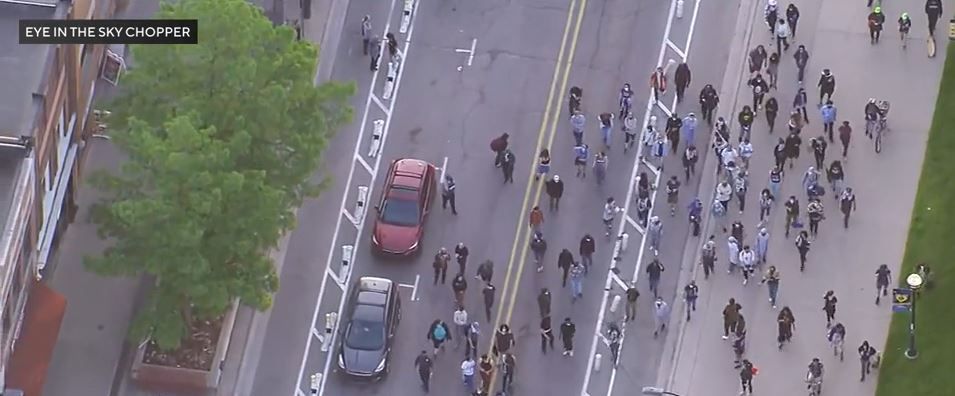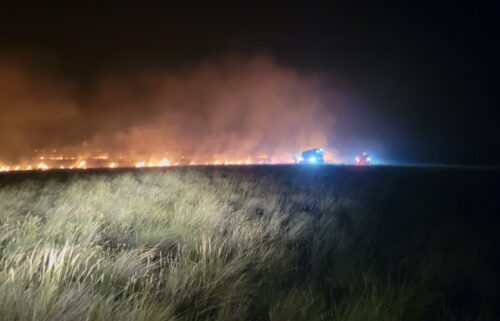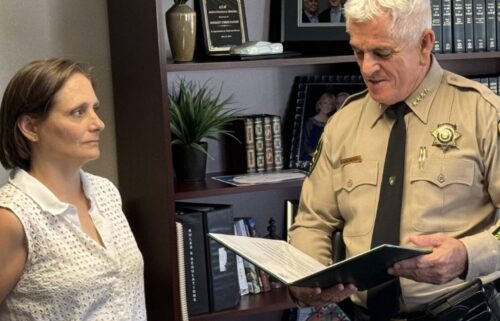Police move in on pro-Palestinian encampment at University of Michigan Diag

Police moved in on the pro-Palestinian encampment at the University of Michigan on May 21.
Click here for updates on this story
DETROIT, Michigan (WWJ) — Police moved in on the pro-Palestinian encampment at the University of Michigan Tuesday morning.
Officers could be seen removing several tents and other items that were set up on the Diag, with the former site of the encampment appearing to be collapsed.
In a video posted on X (formerly known as Twitter) by the TAHRIR Coalition, the group behind the encampment, police appeared to be pepper spraying protesters. CBS Detroit has reached out to police for comment about the incident.
The pro-Palestinian encampment was set up by students in April who were demanding that the university divest from companies that are financially supporting Israel.
University of Michigan President Santa J. Ono released the following statement Tuesday morning regarding police moving in on the encampment:
“The war in Gaza and reactions to it have proven challenging, not just for our university community, but for universities and other institutions both in our country and around the world. Times like these are exactly why freedom of expression is so important and must be honored at public institutions like the University of Michigan. When it comes to freedom of speech, the right to assemble, and the right to protest peacefully, the University’s commitment has been, and will remain, unwavering. Particularly on a university campus, where we are educating young people to become thoughtful citizens, the importance of these freedoms cannot be overstated and, at the University of Michigan, we have a proud history of honoring them and will continue to do so. But those rights are not limitless. The university can and must regulate the time, place, and manner of expression to ensure one group’s right to protest does not infringe on the rights of others, endanger our community or disrupt the operations of the university.
Ensuring that the campus is safe – for students, faculty, employees, university visitors, and protestors – is a paramount concern, which is why the university has provided 24-hour security for the encampment over the past four weeks. Following a May 17 inspection by the university fire marshal, who determined that were a fire to occur, a catastrophic loss of life was likely, the fire marshal and Student Life leaders asked camp occupants to remove external camp barriers, refrain from overloading power sources, and stop using open flames. The protesters refused to comply with these requests. That forced the university to take action and this morning, we removed the encampment.
The disregard for safety directives was only the latest in a series of troubling events centered on an encampment that has always violated the rules that govern the Diag – especially the rules that ensure the space is available to everyone.
The protesters established their encampment on the Diag on April 22, following months of escalating disruptions to university operations – including the disruption of honors convocation and repeated disruptions of classes in academic buildings and study in university libraries. In late April and early May, individuals in the encampment replaced Diag bricks with concrete and painted over the Block M on the center of Diag. Spray paint graffiti was found on walkways, on the Michigan Union sign and on the fountain outside the League. These actions were not free speech; they were destruction of property. A protest outside the University of Michigan Museum of Art descended into violence on May 3. Participants in the encampment helped organize the protest and issued calls on social media for others to join them. Late in the evening, the crowd became unruly and converged in what can only be described as an assault on law enforcement officers. One person, who is not affiliated with the university, was arrested, and multiple police officers sustained minor injuries. While they did not occur on campus, the demonstrations that took place during the early morning hours of May 15 at the homes of several members of the U-M Board of Regents went well beyond the lawful exercise of free speech. Marching and chanting in the middle of the night outside private homes, posting demands on private property, and placing a burnt cradle and fake bloody body bags on the lawn of one regent amounted to vandalism and trespass, not protected expression. While the demonstrators wore masks to hide their identities, they made clear on social media that they were the leaders of the Diag encampment. Moving forward, individuals will be welcome to protest as they always have at the University of Michigan, so long as those protests don’t violate the rights of others and are consistent with university policies meant to ensure the safety of our community. To be clear, there is no place for violence or intimidation at the University of Michigan. Such behavior will not be tolerated, and individuals will be held accountable.
We appreciate that different points of view will continue to be expressed on campus and in our community more broadly, and we are taking steps to broaden the dialogue around these critical matters. In the upcoming year, we will support multiple opportunities to discuss and debate complicated issues, including the war in the Middle East, and explore how universities can contribute to a common path forward in the “Year of Democracy and Civic Engagement.”
We must find productive ways to engage with one another. We must leverage facts and reason in a spirit of open debate and find ways to work toward solutions. If we can manage to do that here – a place that is home to some of the most brilliant minds in the country – then our state, nation, and world will continue to benefit from the diverse perspectives that our university brings together on the most important issues of our day.”
Last week, some of the protesters who organized the encampment went to Board of Regents members’ homes and left fake body bags and toys painted with what appears to be fake blood.
About 30 protestors “staged demonstrations at the private residence of at least one U-M Board of Regents member and went to several others’ residences.”
Regents Sarah Hubbard and Jordan Acker posted on X confirming that protesters had showed up to their homes with demands.
Please note: This content carries a strict local market embargo. If you share the same market as the contributor of this article, you may not use it on any platform.



